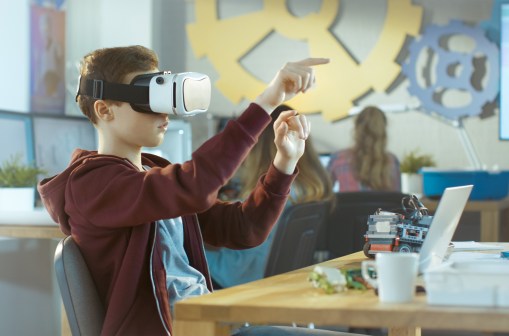One hundred U.S. schools to receive big bump in STEM investment

Dawn Martesi, from Neil Armstrong Middle School used to be a special education teacher. Today, she’s the school’s Verizon Innovative Learning (VIL) instructional coach, overseeing technology implementation and instruction, as well as all of the one-to-one devices provided by the Verizon Foundation as part of a grant the Bristol Township, Pennsylvania, school received several years ago.
To date, the foundation has awarded VIL grants to 100 middle schools across the country. Its new goal, announced Monday, is to enroll another 100 middle schools by the end of 2020 and invest more than $200 million in STEM education. Through this new plan, the foundation hopes to reach additional students the way it has reached those in Bristol Township — 5 million students by 2023, to be exact.
“The whole premise when we got the devices [was] that it wasn’t about having the device, it was about how do you change learning,” Martesi told EdScoop. “It was to focus on how to foster creativity and collaboration. Bristol Township was pretty behind the times before this grant; [it] was like a complete shakeup.”
One element of the VIL program is to implement “Tiger Techs” — selected 8th grade students who provide sort of an in-house IT tech support for both students and teachers.
“It’s kind of a leadership program,” Martesi said. “These 8th graders are in charge of teaching digital citizenship [to younger students], showing teachers new apps.”
Rose Kirk — president of the Verizon Foundation and chief corporate responsibility officer for Verizon — said VIL is not just a grant program.
“This is a true immersive partnership that lasts two or three years, not counting the prep year,” she said. “We provide every single student, teacher and administrator with a device loaded with their study plan … and [we work on] how to immerse the technology into their learning.”
For the next two weeks, through April 15, students, parents, teachers and administrators of middle schools across the United States can use Twitter to nominate their schools for the Verizon Innovative Learning program.
“Advocates should quote tweet and/or reply to one of a series of videos posted to the @Verizon Twitter handle … along with the school name and location, using #Humanability,” the company said in a statement.
The videos highlight the impact the VIL program has had on the schools that already are participating. When the NCAA men’s basketball championship game is on Monday night, one of the videos will be aired.
“This is an opportunity for us to evaluate and identify which ones to add to our partnership,” said Kirk.
Because the grant program is intended to help schools that don’t have as many resources, it is “focused on schools where there’s a significant amount of free or reduced lunch [participation], typically around 60 percent,” she said.
The VIL program targets middle schools because “that age is the sweet spot — kids are either motivated or turned off, the curriculum becomes harder, there’s more discipline,” Kirk said. The goal is to create a one-to-one curriculum — as was done in Martesi’s middle school — where every student and teacher has a device and lesson plans are tailored to each kid’s needs.
For those schools that are selected, it will be close to a year before technology shows up in the classroom. The foundation first invests a year in getting the school ready for the program.
“Teachers need to know what they’re going to do,” Kirk explained. “It’s making sure even at the district level they understand what’s involved … that devices are locked down, they have a management plan, making sure lesson plans are appropriately integrated, that [we] know what the school’s particular challenges are. [When] they kick off in the fall, they’re ready to rock and roll with the kids.”
Reach the reporter at pwaitster@gmail.com and follow her on Twitter @WaitPatience and @edscoop_news.




